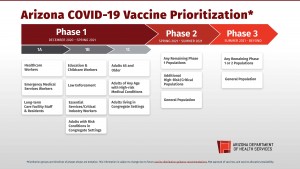 On Friday, December 11, the FDA announced its approval of an emergency use authorization for Pfizer’s COVID-19 vaccine. CDC’s Advisory Committee on Immunization Practices (ACIP) met on Saturday, December 12, and recommended the vaccine for people age 16 and older. This week, the first doses of COVID-19 vaccine arrived in Arizona. The first vaccine clinics will be launched in Maricopa and Pima counties this week with healthcare workers initially prioritized. Today or tomorrow, we expect FDA to determine approval of an emergency use authorization of the Moderna COVID-19 vaccine, which would be followed by shipments of vaccines to all counties and four tribes the week of December 20 for healthcare worker vaccination. An overview of our vaccine plan and the full plan (which is updated as we learn more) are posted on our vaccine webpage.
On Friday, December 11, the FDA announced its approval of an emergency use authorization for Pfizer’s COVID-19 vaccine. CDC’s Advisory Committee on Immunization Practices (ACIP) met on Saturday, December 12, and recommended the vaccine for people age 16 and older. This week, the first doses of COVID-19 vaccine arrived in Arizona. The first vaccine clinics will be launched in Maricopa and Pima counties this week with healthcare workers initially prioritized. Today or tomorrow, we expect FDA to determine approval of an emergency use authorization of the Moderna COVID-19 vaccine, which would be followed by shipments of vaccines to all counties and four tribes the week of December 20 for healthcare worker vaccination. An overview of our vaccine plan and the full plan (which is updated as we learn more) are posted on our vaccine webpage.
To prepare for the initial limited supply of vaccines, ACIP recently released guidance for prioritizing these initial doses. This guidance, coupled with other recommendations were considered on December 3 and again on December 14 during meetings of Arizona’s Vaccine and Antiviral Prioritization Advisory Committee (VAPAC). This committee, comprised of members from state and local public health agencies, healthcare provider groups, and other subject matter experts, is tasked with making recommendations to the state about how to prioritize limited doses of vaccine in a fair and equitable manner, while maximizing the benefit of vaccine and making the biggest impact in preventing COVID-19 in vulnerable groups. Members specifically consider which population subgroups should be prioritized for initial vaccine doses and the order in which these groups should receive vaccine. A December 3 meeting summary, presentation, and the group’s final recommendations are all posted on our website.
VAPAC recommended three phases for initial vaccine allocation:
- Phase 1A, which includes healthcare personnel, healthcare support occupations, and long-term care facility residents at highest risk of disease and death, including staff at these facilities;
- Phase 1B, which includes adults with high-risk medical conditions living in shelters or other congregate settings and essential workers who keep our communities operating and ensure we have the things we need for everyday life such as power, water, food, transportation, or critical services. Workers in educational settings and protective service occupations are prioritized among the essential worker categories; and,
- Phase 1C, which includes adults with underlying medical conditions, those 65 years and older, and adults living in congregate settings
It is possible that groups may need to be further prioritized within the phases listed above, depending on vaccine supply. For example, with limited initial doses of vaccine, local jurisdictions may prioritize healthcare workers with the highest risk of exposure for the first doses of vaccine.
This framework for vaccine prioritization is intended to support local health departments as they work with healthcare providers to get their communities vaccinated. While the arrival of a COVID-19 vaccine is a welcome development in our COVID-19 response, we have several months before there will be enough available to vaccinate all Arizonans who want to be vaccinated. Until that time, please continue to do your part to slow the spread of COVID-19 by wearing a mask and staying physically distanced when you are around people who don’t live in your household, moving your gatherings outdoors and limiting their size, and staying home if you’re sick or have been exposed to someone with COVID-19.









